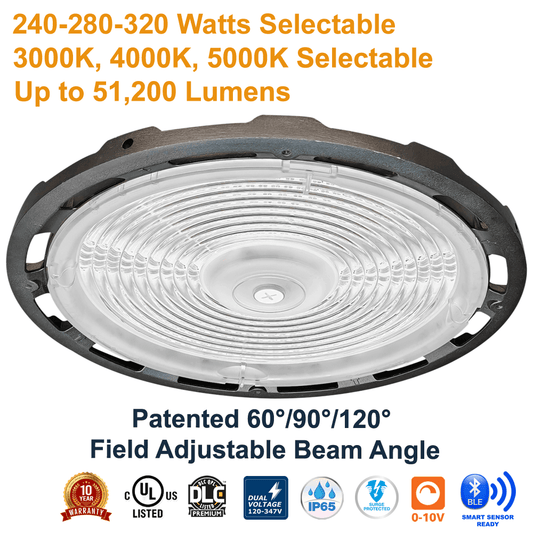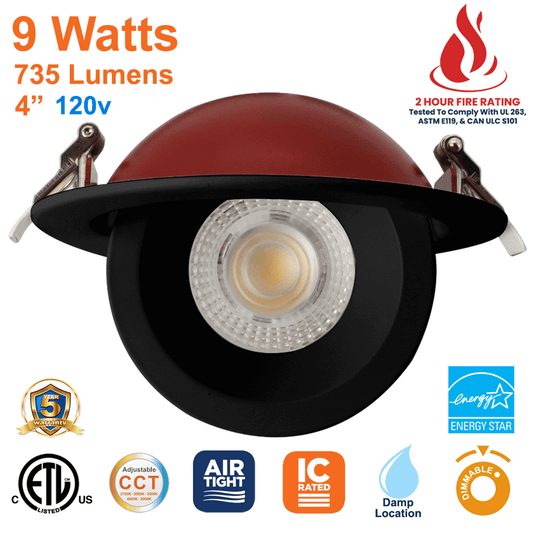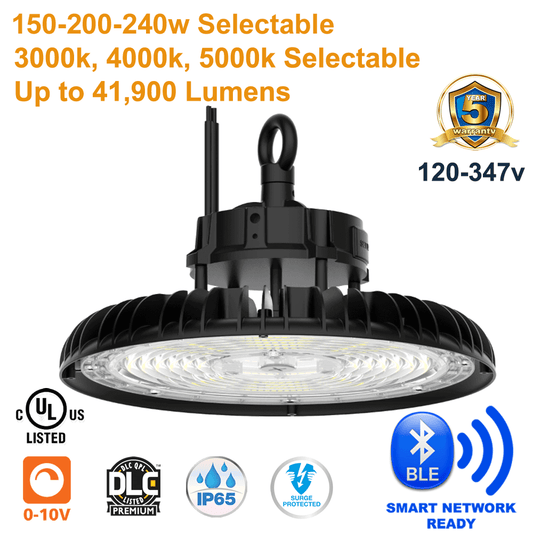When it comes to commercial and industrial LED lighting, dimming functionality can significantly impact the atmosphere, energy consumption, and overall lighting experience. One of the most widely recognized and utilized dimming protocols is 0-10v dimming. But, what is it exactly? And how does it differ from other dimming methods available on the market?
What is 0-10v Dimming?
At its core, 0-10v dimming is a way to control the brightness of LED lights. The "0-10v" represents a continuous voltage range, where 0v corresponds to the minimum light output and 10v to the maximum. It’s as straightforward as turning the volume knob on your stereo, adjusting from low to high.
The Origin of 0-10v Dimming
The 0-10v dimming system was developed as an answer to the increasing need for energy-efficient and controllable lighting solutions in the industrial and commercial sectors. It bridged the gap between the traditional lighting methods and the potential of LED technology, offering both power-saving and aesthetic advantages.
Functionality at its Best
So, how does 0-10v dimming work? Imagine you have LED High Bay fixtures lighting a warehouse. By sending a voltage between 0 and 10 volts from a control device to the light fixture, you can adjust the brightness seamlessly.
Why is it the chosen method for dimming LED lights, like LED Panel Lights and LED Strip Lights? This is due to its compatibility with many fixtures and its ability to provide consistent and stable dimming without the flickering issues some other methods might exhibit.
Weighing the Pros and Cons
Advantages:
- Energy Efficiency: Using 0-10v dimming conserves energy by reducing light output when full brightness is not necessary.
- Versatility: It's compatible with various fixtures, including exterior lighting fixtures, such as Area Lights and Wall Packs
- Smooth Operation: Provides flicker-free dimming, ensuring a consistent lighting experience.
- Quick Easy Installation. Wireless Networked LIghting Controls can be quickly and easily incorporated with compatible LED fixtures.
Disadvantages:
- Wiring Complexity: If you choose not to use a wireless system, 0-10v dimming requires additional wiring, which increases installation time and material costs.
- Limited Range: Some 0-10v LED fixtures don’t dim lights to complete darkness, or “off’, those fixtures will always have a minimal light output.
Networked Lighting Controls, especially Wireless Networked Lighting Controls, have made waves in the industry. They offer advanced features like scheduling, occupancy sensing, and more. But do they utilize 0-10v dimming? Absolutely. It integrates seamlessly, allowing for enhanced control and potential cost savings.
Speaking of savings, one might wonder, how do wireless Networked Lighting Controls cut down on the installation costs of 0-10v dimming LED fixtures? The answer lies in the reduced labor and material costs due to the elimination of control wiring. Additionally, integrating controls like these can make installations quicker and more efficient.
Going Beyond 0-10v
It’s essential to distinguish between 0-10v and its counterpart, 1-10v dimming. While they sound similar, the latter starts at 1v, meaning the light will never be completely off, unlike 0-10v.
On the topic of LED lights, an often asked question is, "Will a 0-10v dimmer work with a normal LED bulb?" The answer varies based on the bulb's compatibility and its driver. It’s always best to check the product specifications or consult with experts, such as those at LED Network.
For a deeper dive into LED dimming and more insights, you might find this guide helpful.
In the next segment of our article, we'll explore the technical aspects of 0-10v dimming, including its wiring, differences from other dimming types, and more. So stay tuned and ensure you’re equipped with everything you need to know about this innovative dimming solution.
Taking A Deeper Look at 0-10v Dimming
With the basics of 0-10v dimming understood, let's venture deeper into its technical intricacies, explore some common questions, and discover how it compares with other dimming technologies.
The Technical Breakdown
Is 0-10v Dimming Analog or Digital?
In the world of lighting controls, 0-10v dimming is predominantly an analog control. Analog signals, like the continuous voltage range in this dimming method, adjust in real-time and offer smooth transitions in brightness levels.
Wiring of 0-10v Dimming
Understanding how 0-10v dimming is wired is vital for both safety and functionality. Typically, two additional wires are required apart from the primary power wires: one for the positive and one for the negative dimming control. These wires carry the control voltage to the fixture, modulating the light output. For a comprehensive look at LED components, check out this LED Driver guide.
Maximum Distance & Shielding
When considering installation, the length of the 0-10v dimming wires matters. The maximum recommended distance for these wires is often around 300 feet to maintain signal integrity. But does 0-10V dimming wire need to be shielded? In environments with potential electromagnetic interference, shielded cable is advisable to prevent signal disruption.
Low Voltage & Power Supply Queries
Yes, 0-10v dimming is a low-voltage control method. This low voltage not only ensures safer installations but also promotes energy efficiency. And if you've ever wondered why some LED 0-10v dimming drivers come with a 12v power supply, it’s typically to provide auxiliary power for sensors or other supplementary devices.
Comparisons with Other Dimming Methods
Phase Dimming vs. 0-10v Dimming
While 0-10v uses direct current voltage signals, phase dimming adjusts the voltage waveform either at the beginning (leading-edge) or the end (trailing-edge) of the AC cycle. Phase dimming is more common in residential settings, while 0-10v finds its home in commercial and industrial environments.
PWM vs. 0-10v Dimming
PWM, or Pulse Width Modulation, dims lights by rapidly switching them on and off. This high-frequency pulsing can achieve precise dimming levels. However, while PWM offers excellent granularity in control, 0-10v remains more straightforward and widely compatible, especially with fixtures like the UFO High Bay LED Lights.
DALI vs. 0-10v Dimming
DALI (Digital Addressable Lighting Interface) is a more complex digital lighting control method. Unlike the continuous voltage in 0-10v, DALI sends digital signals to each light fixture. While DALI offers more flexibility and individual light control, 0-10v stands out for its simplicity and broader acceptance in the market.
Exploring Compatibility
0-10v dimming is largely associated with LED lighting. But can it work with older technologies? Fluorescent lighting, for instance, can be compatible with 0-10v dimming if equipped with the appropriate ballast. On the other hand, HID (High-Intensity Discharge) lighting, like Metal Halide, is more challenging to dim and typically does not support 0-10v dimming reliably.
For more enlightening insights on LEDs, their operation, and intricacies, feel free to browse here.
In the concluding part of our article, we will take a look at more intricate details and provide you with insights to make informed decisions regarding 0-10v dimming in your lighting projects. Stay illuminated!
Wrapping Up: 0-10v Dimming in a Nutshell
As we conclude our deep dive into 0-10v dimming, it's essential to summarize its role in the current lighting landscape and its inherent advantages for industrial and commercial setups.
The Essence of 0-10v Dimming
When optimizing commercial spaces, such as warehouses or office buildings, 0-10v dimming emerges as a formidable choice. Its design caters to a wide range of fixtures, from LED Panel Lights to efficient LED Strip Lights.
Advantages of 0-10v Dimming
-
Simplicity and Reliability: This system is straightforward to understand and use. Its reliability stems from years of field-proven performance.
-
Energy Efficiency: By modulating light levels according to needs, significant energy savings can be achieved. This, in turn, promotes sustainability and reduces costs.
-
Compatibility with Networked Controls: Networked Lighting Controls, especially wireless versions, are revolutionizing how we manage lighting. 0-10v dimming integrates seamlessly with these systems, making it possible to have granular control over lighting in large establishments, reducing installation costs in the process.
Some Disadvantages
However, like all technologies, 0-10v dimming isn't without drawbacks:
-
Lack of Two-Way Communication: Unlike digital control systems like DALI, 0-10v is unidirectional. It sends signals to the fixture but cannot receive feedback, unless you are using Networked Lighting Controls.
-
Potential Minimum Light Level Limitations: Some fixtures might not dim down to absolute zero, depending on the driver's design and capabilities.
Making Informed Choices
When deciding on lighting controls, one must understand the environment and specific requirements. For instance, while a standard 0-10v dimmer might not work efficiently with an LED Light Bulb, it's perfect for controlling groups of fixtures in larger spaces.
Further, understanding differences between seemingly similar terms is vital. A notable distinction to remember is between 0-10v and 1-10v dimming. While both sound similar, the latter begins dimming at 1v, implying it doesn't entirely turn off the fixture.
In Conclusion
Lighting, and by extension, its control, plays a crucial role in shaping the ambiance, utility, and energy efficiency of a space. With technologies like 0-10v dimming, customization becomes accessible. As with any technology, the best results come from an informed approach.
For a more detailed exploration of how LED lighting is shaping our world and the multiple ways to control and optimize them, visit the comprehensive LED Network Blog. Dive into the world of lighting with us and light up your spaces in the most efficient and effective ways possible.



























